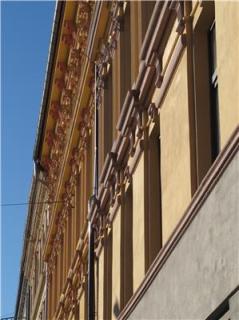Dec 1 2015
Using an old 19th century apartment block in Oslo as a case study, researchers are looking for conservation measures for heritage buildings.
 A list of the measures suggested by the researchers for heritage buildings will appear in a final report to be published in 2017. Photo: NIKU
A list of the measures suggested by the researchers for heritage buildings will appear in a final report to be published in 2017. Photo: NIKU
How can we make them watertight, insulated and protected against future climate change?
"Up to 80 per cent of our current building stock will still be standing in 2050. This means that many of the buildings of the future have already been constructed, and many that were constructed before 1900 are now defined as heritage buildings. If we are to adapt them to future climate change, and make them more energy efficient, then we need customised solutions so as not to damage them or degrade their heritage value", says Cecilie Flyen at SINTEF. "Even minor measures can have a positive effect. For example, clearing out gutters and directing waste water away from the body of a building can protect it from moisture loads".
Researchers at SINTEF and the Norwegian Institute for Cultural Heritage Research (NIKU) have now defined a range of proposed measures that can be applied to Norwegian heritage buildings, and which are also relevant for the remainder of the building stock.
Water and moisture damage
SINTEF is working with the NIKU, which has conducted structural surveys on an apartment block in Grünerløkka. The block is part of an extensive conservation area known as Birkelunden.
"This is an entire residential area from the 19th century that is still intact", says Flyen’s colleague Åsne Lund Godbolt. "The area is complete with a park, church, housing and businesses".
The majority of the area Grünerløkka in Oslo is sited on clay. This meant that when the buildings were constructed, timber rafts had to be laid under the foundations to stabilise the ground.
"This means that the biggest challenge is water in the cellars and courtyards", adds Flyen. "When researchers from NIKU opened a hatch in a cellar, it was like looking down a well. This means water pressure on the foundation walls and moisture problems in the courtyard. The main moisture load is related to drainpipes from the roof and water splashing up against the wall, as well as water being drawn up from the ground. Ice and water then spread through the wall, which develops cracks".
Water in cellars creates challenges, according to the researchers. In this particular case, if any changes are made to the drainage system in order to divert water around the cellar, there is a risk that the moisture conditions deeper underground will be affected. Since the underground timber rafts have to remain covered with water, this could cause them to rot.
Not replaced, but repaired
Information about the condition of the building will be passed onto the residents. They have already been interviewed by the researchers.
The housing block contains small apartments, many of which are first-time apartments for young people and students. The residents are often environmentally aware and interested, but tend not to be so able or willing to invest. Many regard the conservation status as a restriction and a problem.
"What can they do to help"?
"Learning to look and record areas of potential damage is important. For example, if moisture damage is not detected and allowed to develop, the building may become increasingly more vulnerable to climate change. With even greater levels of precipitation expected, this vulnerability increases".
"What are they not allowed to do to the building"?
"The façade is protected, so they cannot retrofit external insulation to walls or replace windows without permission. But they can make the windows watertight, and insulate and repair them. The windows have been replaced many times in the past, and those there now are of a poor quality and do not match. Most of the original windows are found in the stairwells".
Enova measures not working well
One finding is that several of the Enova measures do not work well for heritage buildings. For example, the company provides grants for retrofitting insulation and for replacing windows, but since the façade is protected, this won’t work in Grünerløkka.
Replacing something can cause changes that damage the structure and degrade the technical standard of the building. For example, old houses were built to breathe. New materials such as plastic and other waterproofing materials only serve to lock in the moisture.
The right type of plaster is essential in heritage buildings.
"The wrong type of plaster can destroy old mortar and bricks, and can make the surface too rigid and watertight", explains Flyen. She tells us that the project now has a Master's student on board, who will be looking at indoor climates, taking energy measurements, and assessing the quality of life in two of the apartments. This will add great value to the project.
Grateful
The researchers are grateful to have been granted access to the building in Grünerløkka, and to have been allowed into stairwells and cellars to inspect damage.
"That was incredibly valuable, and allows us to provide general descriptions of actions we can take", says Åsne Lund Godbolt. "It is also informative for the residents and makes them conscious that they are living in a special building. In particular, it makes them aware of the need to record minor damage so as to prevent the situation from developing into something worse. The accumulation of many areas of minor damage can put a major load on an old building".